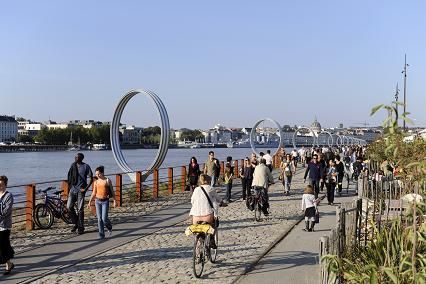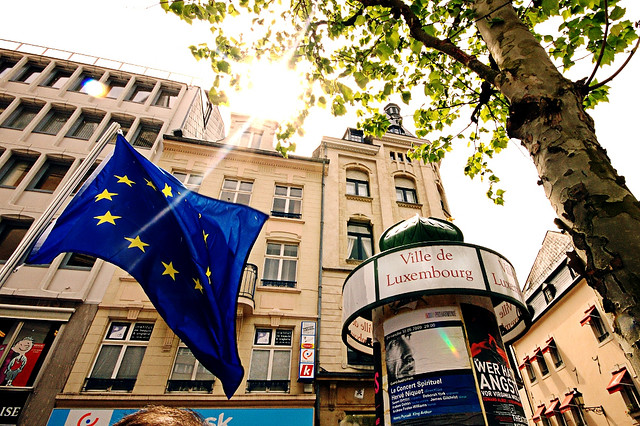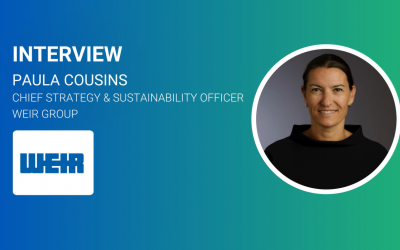Urban sustainability in the European Union
Three quarters of Europeans live in cities, and accordingly, their quality of life and the quality of their environment depends upon how cities look and how they function. European urban areas face a number of environmental challenges and although the scale and intensity of the problems vary between cities, a common set of issues can be identified.

Many cities are confronted with poor air quality, high volumes of traffic and congestion, rising levels of greenhouse gas emissions and ambient noise, a scarcity of quiet areas for sport, play and recreation, urban sprawl and large volumes of waste and wastewater. Demographic changes due to the consequences of economic stagnation in terms of job creation and social progress, and the tangible effects of climate change are recent additions to the list.
These are serious challenges that have significant impacts on health, the environment and the local economy. Like all environmental challenges they are also interdependent, with many issues having an impact on other areas. Finally they touch people's lives at a very concrete level – the way they make business, the air they breathe, the way they move and their daily surroundings – making it necessary to involve everyone, citizens, businesses, local, national and regional authorities in decision-making.
What is more, what happens on the local level also influences wider levels, in terms of environmental impacts that know no borders, and policy decisions. Effective responses to these challenges at local level are critical for achieving the smart, sustainable, inclusive growth and society envisaged in the Europe 2020 Strategy.
This is why integrated environmental management is key to urban sustainability.
An integrated approach to urban environmental management
Because the environmental, economic, social and cultural aspects of urban life are all interwoven, success in urban management can only be achieved through an integrated approach.
Integratedurban policies can nurture a consistent approach to urban sustainability. Measures for environmental protection must be combined with those for physical urban renewal, integrated spatial planning, economic development, education and social inclusion. Strong partnerships between local citizens, civil society, the local economy and the various levels of government are a pre-requisite to ensure coherency and effective action.
This integrated approach pays multiple dividends. Improving ambient air quality means reducing greenhouse gas emissions. Making urban transport more sustainable implies carefully considering land use and planning to avoid urban sprawl. Increasing biodiversity and green space can help prevent noise and protect quiet areas, and improving waste management can contribute to increased energy efficiency.
Each city needs to have a clearly defined, widely understood and supported environmental long-term vision for the municipality, as part of a broader commitment to urban sustainability. This vision needs to be reflected in different strategies and action plans, which include objectives and targets for individual sectors such as climate change and energy, transport, green areas, nature, air, noise, water, eco-innovation.
On the other hand all stakeholders (government, business, academia, citizens including young people) should be invited to participate in the development of the city’s environmental vision and associated strategies and action plans. Involving citizens in urban planning helps ensure sustainable economic development and plays a vital role in providing well-planned and well-governed cities. As citizens are deeply affected by urban planning, authorities need to make sure that they are involved and offered a forum where they can express their opinions. This requires practical arrangements like management circles, obligatory sustainability assessments (assessment of environmental, social and economic effects of policy proposals), project structures, promoting of skills or periodic evaluations.
Citizen participation is not only the most effective way of involving people in local dynamics – it's also a right. The EU is a signatory to the Aarhus Convention on access to information, public participation in environmental decision-making and access to justice, which enshrines the right of citizens to participate in urban planning processes.
How does the European Commission promote this integration?
An integrated approach to urban environmental management is the building block of EU urban sustainability policies. The Thematic Strategy on the Urban Environment (2006) outlines the European Commission’s commitment to support and encourage Europe’s towns and cities to adopt a more integrated approach to urban management. The need for better integration at urban level has also been reflected in the 7th Environmental Action Programme (2014-2020) recently proposed by the European Commission. The proposal aims to see a majority of cities in the EU implementing policies for sustainable urban planning and design by 2020, and it promotes a coherent, integrated approach to sustainable urban development.
The European Union also encourages urban sustainability and integration through a number of initiatives. The European Green Capital Award recognises and rewards local efforts to improve the environment, the economy and the quality of life of growing urban populations. It also acts as a platform for exchange of ideas and opportunities. It encourages people and cities to learn from one another to devise solutions to city problems.
To date, the European Green Capital Award has been bestowed on five cities – Stockholm (2010), Hamburg (2011), Vitoria-Gasteiz (2012), Nantes (2013) and Copenhagen (2014). These winning green capitals have proven that cities can strike a balance between economic growth, environmental protection and quality of life. And they have achieved this through integrating these elements in their decision-making.
For example the medium-sized city of Vitoria-Gasteiz has been very good at involving its citizens in the local decision-making process. Winning the European Capital Award in 2012 created a sense of belonging and pride among its citizens that spurred a wave of participation in green activities: 143 citizens participated in the volunteer program Ekolabora, 204 citizen initiatives applied for green subsidies, 703 local businesses signed a 'green deal' with the mayor, and more than 3,000 citizens visited the green factories.
The European Commission also supports cities in the exchange and application of good practices to improve energy efficiency and promote low-carbon business and economic development, through the Covenant of Mayors. More than 1,900 European cities have committed to go beyond the EU emission reduction targets of a 20 % cut in CO2 emissions by 2020 – through the development and implementation of Sustainable Energy Action Plans under the Covenant of Mayors. These local commitments are integrated in a more global reflection and policy action. The Commission also provides measures to identify emissions reduction opportunities – including better energy efficiency in buildings and green mobility – and funding to help them come to fruition.
Green buildings that require less energy for lighting, heating and cooling through clever use of glass and innovative air flow systems are an important component of the effort to achieve efficient and sustainable European cities. The Commission promotes green buildings through several measures including the Energy Performance of Buildings Directive, which sets minimum standards requiring Member States to make new and existing buildings more energy efficient. The European Commission’s Green Building Programme supports this, encouraging renewable energy to be integrated into non-residential buildings.
Frankfurt’s German Passive House Standard is an excellent example to follow. In 2005 ABG Frankfurt Holdings decided that all new buildings would be consistently constructed as low energy passive houses, which means that their heating energy needs must be less than 15 KWh/m2. The company pioneered the launch of passive house technology in multi-storey homes, and Frankfurt now holds the European record for the number of buildings constructed to passive house standards.
A number of important practical tools also exist to strengthen protection of the urban environment in promoting more integration.
One of them is an Integrated Environmental Management System (IEMS) – a strong voluntary commitment by the city to act on its environmental problems. A well-developed IEMS helps avoid conflicts by considering the competing demands between various policy areas and initiatives (economic well-being, competitiveness, health, environment, spatial planning), and by setting long-term goals.
An IEMS is often linked to a Local Agenda 21 initiative. Under the 1994 Aalborg Charter of European Cities & Towns towards Sustainability, many European cities committed to engage in preparing these local action plans towards sustainability; to date, more than 5000 Local Agenda 21 strategies have been developed in Europe.
EU guidance on IEMS in urban areas provides best practice examples and experiences. In developing their IEMS, many urban areas may also follow the guidelines set out in the EU Regulation for a voluntary Eco-Management and Audit Scheme (EMAS).
The EU has also developed two mandatory procedures for cities to assess the potential environmental impacts of their plans programmes and policies. They enable cities to ensure that environmental consideration is given to plans likely to have significant effect on the environment such as road building projects. These tools are the Strategic Environmental Assessment Directive for public plans and programmes, and the Environmental Impact Assessment Directive for certain public and private projects.
Tracking progress through self-evaluation and critical analysis is essential if Europe is to stay on top of its environmental challenges. The EU has developed guidelines and tools for this such as Local Evaluation 21, an online self-assessment tool for participating cities to gauge the progress of their sustainable development processes.
How will integration of urban sustainability contribute to achieving EU policy priorities
Resource efficiency
To function efficiently, cities and towns need to lower their use of scarce natural resources. Resource efficiency is based on the ideal of an integrated, closed-loop economic system that manages resources from cradle to cradle.
The Roadmap to a Resource Efficient Europe launched by the Commission in 2011 outlines how we can transform Europe’s economy into a sustainable one by increasing resource productivity and decoupling economic growth from resource use and its environmental impact. It illustrates how policies inter-relate and build on each other. Turning waste into a resource through recycling, improving buildings' energy efficiency, ensuring energy efficient mobility are some of the actions put forward in the roadmap.
 Cities have a key role to play in the economic transformation toward resource efficiency. They have a number of instruments in their hands, such as green public procurement, waste and water management, improved mobility, housing improvements, stimulating eco-product markets, and urban planning. We are also starting to talk about urban mining. You can get 100 times more gold from a tonne of discarded mobile phones than from a tonne of gold mine ore.
Cities have a key role to play in the economic transformation toward resource efficiency. They have a number of instruments in their hands, such as green public procurement, waste and water management, improved mobility, housing improvements, stimulating eco-product markets, and urban planning. We are also starting to talk about urban mining. You can get 100 times more gold from a tonne of discarded mobile phones than from a tonne of gold mine ore.
Green infrastructure and efficient land use are also important to become more resource efficient. Cities benefit in many ways when they establish networks of high quality green spaces, using nature to deliver multiple benefits. In the EU, green infrastructure projects financed through our LIFE+ programme (www. http://ec.europa.eu/environment/life/index.htm) have shown that ecosystem enhancement can go hand in hand with, for example, protection against flooding, and support for the tourism sector. The deployment of green infrastructure creates jobs for integrated planning in urban areas, for the construction of green roofs and walls, planting and maintaining the city's forests and park systems, for the restoration of brown field sites and opening up river courses flowing through the city. Investing in green infrastructure also saves money – it is more resilient and often cheaper than purely technical solutions in the long run.
Air quality
Many of the air problems we experience today are related to cities, with their dense population, high level of economic activity, and intense traffic. It is in cities that local and European challenges come together. Urban pollution is partly a matter of local emissions, but those emissions rest on a background concentration stemming from other parts of the same Member State, or from transboundary sources. We need to work at all levels of decision-making, from local to European to address this issue effectively, also by tapping the full potential of international cooperation . The more integrated the approach, the more efficient the decisions will be.
Despite progress in recent years, several air quality standards are still widely exceeded in the EU's most densely populated areas, especially from pollutants such as particulate matter, ground-level ozone, and nitrogen dioxide. Janez Potočnik, the European Commissioner for the Environment, has declared 2013 the "Year of Air". So we are in the process of reviewing the Commission's air policy, with a focus on finding ways to improve the quality of the air we breathe. Based on the review, that involves extensive consultations of a wide range of actors, including citizens and local authorities, the Commission will propose measures to improve its policies.
As citizen concern about air quality grows, the demand for low emission products and processes can be expected to increase dramatically. In that respect air quality policy is therefore not only an environmental objective, but also an economic opportunity and a driver for innovation. A strengthened air quality regime in the EU will actually benefit European competitiveness. And cities will have to play their role of engines of the economy, places of connectivity, creativity and innovation.
Conclusion
If we want cities to become more sustainable we need to motivate and encourage them to take an integrated approach to policy delivery in all dimensions, with more horizontal integration between environmental sectoral policies, and vertical integration between levels of governance at the local, national, regional and European levels, while ensuring the involvement of all stakeholders. The European Commission provides many tools and frameworks (including proactive initiatives and funding) to help Member States to promote this integration, laying the foundations for a sustainable future.




_400_250_s_c1.png)




